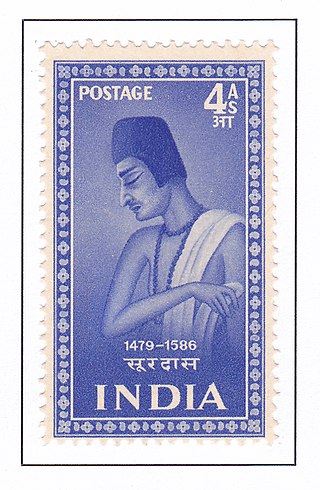
Surdas was a 16th-century blind Hindu devotional poet and singer, who was known for his works written in praise of the deity Krishna. He was a Vaishnava devotee of Krishna, and he was also a revered poet and singer. His compositions captured his devotion towards Krishna. Most of his poems were written in the Braj language, while some were also written in other dialects of medieval Hindi, like Awadhi.

Dichomeris is a genus of moths in the family Gelechiidae erected by Jacob Hübner in 1818.
Ephysteris is a genus of the twirler moth family (Gelechiidae). Among these, it is assigned to tribe Gnorimoschemini of the subfamily Gelechiinae. Even though it is a rather diverse and widespread group, most of these small and inconspicuous moths were overlooked by scientists until the early 20th century. Almost 90 species are known today but new ones are still being discovered.

Surda is a Palestinian town in the Ramallah and al-Bireh Governorate, located northeast of Ramallah in the northern West Bank. According to the Palestinian Central Bureau of Statistics (PCBS), the town had a population of 1,308 inhabitants in 2017.

Gelechiinae is a subfamily of moths in the family Gelechiidae. It was described by Henry Tibbats Stainton in 1854.
Ephysteris aulacopis is a moth in the family Gelechiidae. It was described by Edward Meyrick in 1923. It is found in Nepal and Assam, India.
Ephysteris infirma is a moth in the family Gelechiidae. It was described by Edward Meyrick in 1912. It is found in the Democratic Republic of the Congo and South Africa (KwaZulu-Natal).
Ephysteris juvenilis is a moth in the family Gelechiidae. It was described by Edward Meyrick in 1929. It is found in Assam, India.
Ephysteris leptocentra is a moth in the family Gelechiidae. It was described by Edward Meyrick in 1912. It is found in Sri Lanka, southern India, Bengal and Myanmar.
Ephysteris semiophanes is a moth in the family Gelechiidae. It was described by Edward Meyrick in 1918. It is found in Sri Lanka.
Ephysteris sirota is a moth in the family Gelechiidae. It was described by Edward Meyrick in 1908. It is found in the South Africa provinces of Gauteng, KwaZulu-Natal and Limpopo.
Ephysteris suasoria is a moth in the family Gelechiidae. It was described by Edward Meyrick in 1918. It is found in southern India and Palestine.
Ephysteris subcaerulea is a moth in the family Gelechiidae. It was described by Edward Meyrick in 1918. It is found in southern India.
Ephysteris synecta is a moth in the family Gelechiidae. It was described by Edward Meyrick in 1909. It is found in Namibia, Zimbabwe and Gauteng, South Africa.
Ephysteris brachypogon is a moth in the family Gelechiidae. It was described by Edward Meyrick in 1937. It is found in South Africa.
Ephysteris insulella is a moth in the family Gelechiidae. It was described by Hermann von Heinemann in 1870. It is found in France, Germany, Switzerland, Italy, Bulgaria, Romania and Russia. Outside of Europe, it is found in south-eastern Kazakhstan, southern Siberia, Mongolia and China.
Ephysteris scimitarella is a moth in the family Gelechiidae. It was described by Bernard Landry in 2010. It is found on the Galápagos Islands.
Ephysteris sporobolella is a moth in the family Gelechiidae. It was described by Bernard Landry in 2010. It is found on the Galápagos Islands.



